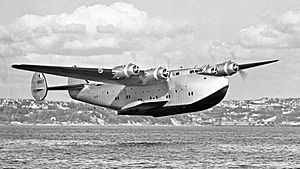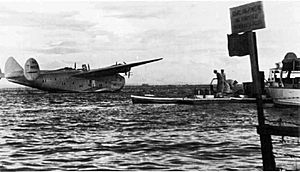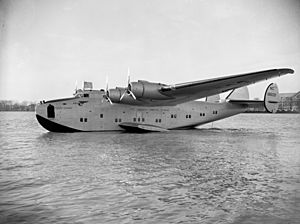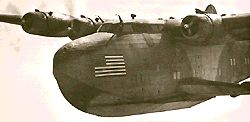Boeing 314 facts for kids
Quick facts for kids 314 Clipper |
|
|---|---|
 |
|
| A Boeing 314 “Clipper” | |
| Role | Flying boat airliner |
| Manufacturer | Boeing Airplane Company |
| First flight | June 7, 1938 |
| Introduction | 1939 |
| Retired | 1946 |
| Status | Retired |
| Primary users | Pan American World Airways British Overseas Airways Corporation United States Navy |
| Produced | 1938–1941 |
| Number built | 12 |
| Developed from | Boeing XB-15 (used wing only) |
The Boeing 314 Clipper was a special kind of airplane called a flying boat. This means it could land and take off from water. The Boeing Airplane Company made these planes between 1938 and 1941.
The Clipper was one of the biggest planes of its time. It even used the large wing from an earlier bomber plane, the XB-15. Only twelve Clippers were ever built. Most of them were for Pan Am, a famous airline. Three of these planes were later sold to BOAC during World War II.
Contents
Building the Clipper
Pan Am wanted a flying boat that could fly very far. Boeing decided to build it, and Pan Am ordered six planes. Boeing engineers used a huge wing that was about 149 feet (45 m) wide. This wing came from one of Boeing's older planes.
The new plane had four powerful engines, each with 1,600 horsepower (1,200 kW). These were called Twin Cyclone engines, made by Wright.
The first Boeing 314 flew on June 7, 1938. The test pilot found a few small problems, but Boeing quickly fixed them. After that, the plane worked perfectly.
Weight was very important on these long flights. Passengers could only bring 77 pounds (35 kg) of luggage for free. If they brought more, they had to pay extra for each pound.

Pan Am's "Clippers" were known for being very luxurious. The seats could turn into comfortable beds for overnight flights. The plane flew at about 188 miles per hour (303 km/h), so some trips lasted more than 12 hours!
The 314s had special areas like a lounge and a dining room. They even had chefs from fancy hotels who cooked delicious meals. There were separate dressing rooms for men and women too. The luxury on these planes was amazing, and only very rich people could afford to fly on them. The cost was similar to flying on the super-fast Concorde jet many years later.
The success of the 314 was also thanks to its amazing flight crews. They were experts at flying long distances. Often, an extra crew would be on board for training. Only the very best pilots were chosen to fly the Boeing 314. If it was too foggy to see the runway, pilots sometimes landed the plane on the water and then carefully moved it to the dock.
Clipper History
The first Boeing 314, named Honolulu Clipper, began flying passengers in January 1939.
When World War II started in the Pacific, one Clipper called Pacific Clipper was flying to New Zealand. To avoid being attacked by Japanese planes, it flew all the way around the world to New York instead of going back to Honolulu. This was a very long and dangerous journey!
During World War II, the U.S. military used Pan Am's Boeing 314s. The planes were mostly used for transport, and only their paint changed. Pan Am crews still flew them. The military called these planes C-98s. Famous leaders like Winston Churchill sometimes flew on Boeing 314s.
After the war ended, many Clippers were returned to Pan Am. However, newer, faster planes were being built, and the Boeing 314 was no longer the most modern aircraft.
Retirement of the Clippers
One Pan Am 314, the California Clipper, flew over one million miles before it was retired. Sadly, three Boeing 314s crashed during their service.
Types of Boeing 314
- Model 314
- This was the first version of the plane. Six of these were made.
- Model 314A
- This was an improved version. It had better engines, could carry more fuel, and had a nicer cabin. It could fly for about 4,700 miles. Six of these were also made.
Who Used the Clippers?
Where are the Boeing 314s Today?
Sadly, no original Boeing 314s still exist today. However, you can see a full-size replica (a copy) at the Foynes Flying Boat Museum in Foynes, County Limerick, Ireland.
Images for kids
See also
 In Spanish: Boeing 314 para niños
In Spanish: Boeing 314 para niños







